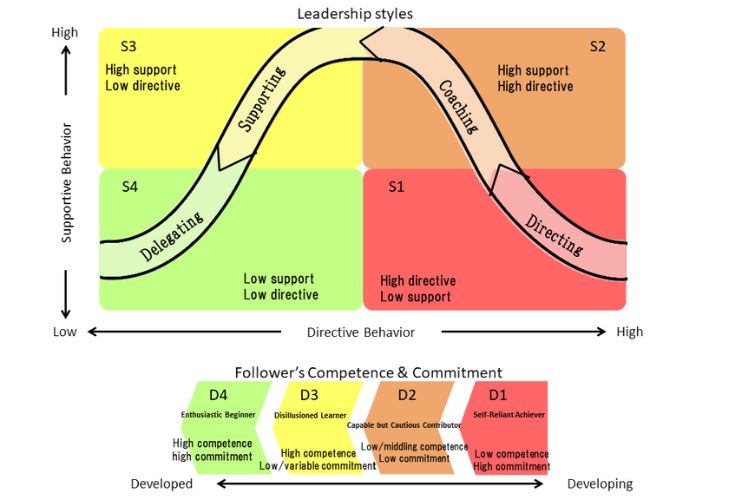Discover the benefits of Situational leadership – plus how to adopt this flexible approach to better perform in management positions.
(by Aaron Ngui)
What is Situational Leadership?
Situational leadership is about how leaders lead in different situations. Initially developed by Paul Hersey and Ken Blanchard in the late 1960s, the concept is based on the idea that leadership is not a one-size-fits-all approach – rather, one is encouraged to be agile, flexible, and responsive to the needs of the people they manage and the tasks at hand. As such, leaders are called to adapt their style based on their team’s maturity or readiness, depending on the specific state of affairs.
Examples:
- A new employee is hired to work on a complex project. The leader uses a telling style to provide them with clear instructions and guidance – while at the same time closely supervising the work to make sure that they are on track.
- A team of experienced employees is working on a new product launch. In this case, the leader utilizes a participating approach to involve everyone in decision-making and problem-solving – as well as constantly supports and encourages others as they work towards their goal.
- A team of highly motivated and skilled employees is working on a critical deadline. The leader adopts a delegating style to give them the autonomy to work independently. Resources are offered as needed, but otherwise, they trust the team to get the job done.
Many organizations have adopted this approach to enhance the effectiveness of their leaders. For example, a survey of 1000 managers from various industries and countries revealed that 54% of them adopted situational leadership as their primary management philosophy – of whom 82% practiced it at least some of the time.

The Formulation of the Situational Leadership Model
The Situational Leadership Theory was introduced by Dr. Paul Hersey and Kenneth Blanchard in the 1960s. While working on it, Hersey specifically looked to find out the answers to the following two fundamental questions:
- What is the most advantageous leadership style?
- What serves as the driving force behind people’s motivation?
Based on his investigations, Hersey concluded that there is no universally optimal approach to leadership, as it hinges on people’s capacity and willingness to tackle specific tasks.
Since its inception, the model has consistently proven to be a valuable tool for those seeking to adapt their management approach to meet the unique requirements of their team members.
Benefits of Situational Leadership
According to a study published in Harvard Business Review – which involves over 1,000 managers worldwide, the notion of adhering to a rigid leadership style, indifferent to the particular context, is outdated. Given the diverse array of challenges confronting modern leaders, there is nothing called a “one-size-fits-all” approach. Instead of striving for a single “sweet spot,” leaders are encouraged to expand their “sweet range” – in other words, be willing to change and adapt depending on the situation.
- Improved team performance
When leaders tailor their leadership to the needs of the team and the members, the team experiences improved performance and higher productivity.
- Better communication
Leaders who are open foster better communication and trust within the team – as it demonstrates his/her understanding of individual strengths and weaknesses.
- Employee satisfaction
As team members feel supported and understood, they are more likely to be satisfied with their work and stay engaged in their roles. In fact, a study by McKinsey has revealed a strong correlation between the willingness to change of leaders and the organization’s overall health.
Situational Leadership Characteristics & Skills
- Flexibility: As mentioned, situational leaders possess the remarkable ability to be flexible in their approach. Depending on the situation, they can seamlessly transition between different styles, whether it be a directive approach for an inexperienced team or a more hands-off approach for a capable and motivated team.
- Awareness: These exceptional individuals possess a heightened sense of awareness – specifically, they have a keen eye for understanding the unique needs and capabilities of each team member. This acute awareness enables them to accurately assess the situation at hand and determine the most appropriate way to manage the team.
- Integrity: Situational leaders are unwavering in their commitment to honesty, trustworthiness, and ethical behavior. Their actions and decisions are guided by a strong moral compass, which fosters trust among their followers. They prioritize the best interests of their people and the whole organization over personal gain.
- Courage: Another distinct trait is their unwavering stance in the face of adversity. These people are unafraid of taking calculated risks and confronting challenges head-on. This courage is paired with resilience, allowing them to bounce back from setbacks and learn from past mistakes.
- Adept at change: Situational leaders embrace change with an open mind. They thrive in environments characterized by uncertainty, ambiguity, and diversity. Instead of “weaseling” away from change, they see it as an opportunity for growth and innovation, constantly seeking new solutions and possibilities.
- Ability to diagnose: Effective situational leaders are skilled diagnosticians – in other words, they are able to assess the competence and commitment levels of others using various tools and methods. As a result, they are quite skilled at identifying problems, needs, and areas for improvement.
- Communication skills: Communication is a cornerstone of effective leadership. These leaders excel at conveying their vision, expectations, and influence in a way that resonates with their followers. They are adept at adjusting their communication style, whether it involves telling, selling, participating, or delegating, to suit the context.
- Empathy: Empathy enables them to connect with others on a personal level. They take the time to understand the needs, motivations, and concerns of their followers, creating a positive and supportive team environment.
- Trust: These individuals trust their team members to carry out their responsibilities effectively. They delegate authority and provide support when needed, cultivating an environment of mutual trust and accountability.
- Clear vision: Situational leaders possess a clear and compelling vision of what they aim to achieve – which they constantly communicate with passion. This shared vision becomes a driving force for the entire team.
- Decision-making skills: Rapid and effective decision-making is another hallmark of situational leaders. They are skilled at making decisions in a timely manner, drawing upon their judgment and expertise. Additionally, they recognize when it’s appropriate to delegate authority to others.
- Problem-solving: Their ability to navigate challenges, coupled with their willingness to teach their team members problem-solving skills, enhances the overall problem-solving capacity of the group.
- Conflict resolution skills: Conflicts inevitably arise within teams. Situational leaders are proficient in resolving conflicts constructively, promoting collaboration and team cohesion. Moreover, they impart these valuable skills to their team members, fostering a harmonious working environment.
Read more: Skill Development – A Guide to Future-Proofing Yourself
The Four Situational Leadership Styles
When it comes to situational leadership, most research proposes 4 distinct styles, determined by two key factors:
- Task/Directive Behavior: This pertains to those providing clear instructions to subordinates regarding the what, how, where, and when of tasks.
- Relationship/Supportive Behavior: This concerns the extent to which leaders engage in open communication with employees, actively listen, acknowledge, and support improvements in work progress.

Situational Leadership chart model – including 4 quadrants divided into stages
Source: Wikimedia
-
Telling (S1)
This is where leaders give clear direction and close supervision. It is most effective when team members are not yet ready, unfamiliar with the task, or are starting a new project.
For example, a manager of a fast-food restaurant who just hired new team members would provide clear instructions, closely supervise the work, and give step-by-step instructions and guidance. The manager would show how the work flows, how to safely handle the food and machines, and constantly ensure that they are following the standard operating procedures.
-
Selling (S2)
Those who use selling provide a high level of direction and support. They encourage team members, while also giving guidance and feedback. In this style, a leader supports the team members to close any skill gaps.
As an example, a programmer needs to learn a new programming language for a new project. The group lead can give detailed guidance on the scope and objectives of the project, breaking it down into manageable phases. He can then arrange for training and mentorship to get the programmer up to speed. Along the way, he offers support, encouragement, and feedback to boost the programmer’s confidence, drive, and motivation.
-
Supporting (S3)
Here, a leader provides less direction – instead, they allow team members to take more initiative. They offer support and encouragement, stepping in only when needed. This approach is recommended if the team has shown they are competent and capable of handling the tasks.
Let’s say we have one person named Sam. She initiates open discussions to encourage a collaborative atmosphere for sharing ideas and solutions. She also facilitates the allocation of tasks, allowing team members to choose what aspects of the work fit their strengths. Rather than resorting to micromanagement, she and the team have set up a dashboard to monitor progress and ensure things are on track.
-
Delegating (S4)
The leader who delegates provides minimal direction. They allow team members to take charge of their tasks independently. It works best when team members are highly capable and motivated – when the team is like a well-oiled machine.
Example: Tom is the manager of a creative agency. His team members have worked together for years, are highly skilled, self-motivated, and have a strong track record of successful campaigns.
For the launch of a new product, he gives them the freedom to choose the tasks that suit their strengths; some conduct market research, some dive into designing the creatives, while others start on the digital side of things. He gives the team the autonomy to work independently – and is available for support and monitor progress to ensure things go well. His aim is to foster a sense of fosters a sense of ownership and responsibility among team members for a successful campaign.
Read more: Leading Through Uncertainty – How to Navigate Turbulent Times
Adapting the Situational Leadership Style
A key principle to effective situational leadership is possessing the ability to adapt to the needs of the team. This means being attuned to the capabilities, willingness, and confidence of everyone. For this purpose, one must constantly place a strong focus on analyzing other’s performance readiness.
Leaders who can discern the strengths and gaps within the team can tailor their approach to provide the right amount of support or empowerment. By adapting to the team members, affirming their values, and instilling a sense of confidence, they nurture a dynamic, cohesive, and high-functioning team, as each member feels understood within their role.
Read more: Building High-performing Teams – Power Up Your People for Success

Situational Leadership Advantages & Disadvantages
Advantages
- Simplicity: One of the key strengths of situational leadership is that it provides a straightforward framework that focuses on two essential elements: the group being led and the specific task at hand. As such, leaders do not have to get themselves used to any specific structure to apply it.
- Trust & Collaboration: Leaders who employ this approach involve their team members in decision-making and problem-solving processes. By offering guidance and support, they motivate others and enhance their engagement and performance.
- Enhanced effectiveness: By utilizing a wide range of skills and techniques tailored to different situations, leaders become much more effective in addressing diverse challenges, adapting to change, and navigating complex situations.
Disadvantages
- Skill requirements: Successful implementation of situational leadership places a significant demand on the individual’s abilities and qualities. To effectively diagnose and adapt to changing circumstances, one is expected to possess a high degree of self-awareness, emotional intelligence, strong communication skills, and sound decision-making capabilities. Such requirements can be daunting, particularly for new or inexperienced managers.
- Organizational confusion: The adaptability inherent in situational leadership may lead to confusion within an organization. As leaders frequently change their approach based on the needs of each team or individual, this may result in inconsistency, unpredictability, and a lack of clarity among followers. For some team members, they may become bewildered and unsure of the leader’s rationale or expectations.
- Measurement challenges: Evaluating the effectiveness of situational leadership is not a simple task. Due to its complexity and multifaceted nature, it is difficult to measure its impact in a quantitative or standardized manner.
How to Practice Situational Leadership
Practicing situational leadership requires a dynamic approach that involves assessing various aspects and scenarios. Below are some key steps to consider when deciding to adopt such an approach:
Assess maturity levels
Start by assessing the maturity level of your followers – by gauging their competence and commitment concerning a specific task or goal. These include:
- M1 (low competence, high commitment) or D1 (Enthusiastic beginner)
- M2 (low competence, low commitment) or D2 (Disillusioned learner)
- M3 (high competence, low commitment) or D3 (Capable yet cautious performer)
- M4 (high competence, high commitment) or D4 (Self reliant achiever)
(D1, D2, D3, D4 are for those who would like to base their assessment on the Situational Leadership II model by Ken Blanchard – also known as SLII)
For each of the aforementioned options, we have one corresponding level of performance readiness:
- R1 (Unable and Insecure or Unwilling)
- R2 (Unable but Confident and Willing)
- R3 (Able but Insecure or Unwilling), and
- R4 (Able and Confident and Willing)
As a side note, remember that one’s maturity level can vary from one task or situation to another.
Match leadership style with the corresponding stage
Once you’ve determined your followers’ maturity levels, it’s time to adjust your leadership style accordingly. The goal is to match your approach to their specific needs.
- For M1, utilize a telling approach (S1). Provide clear and specific instructions, guiding them through the task.
- For M2, adopt a selling style (S2). Explain your decisions, provide support, and encourage their involvement in the process.
- For M3, use a participating/ coaching style (S3). Involve them in decision-making, seeking their input and addressing their concerns.
- For M4, employ a delegating philosophy (S4). Give them autonomy to make decisions and perform tasks independently.
Be flexible
As a leader, you must be fully aware that situations and tasks may evolve over time. For this reason, be flexible and willing to adjust your leadership style as needed. Continuously reassess the maturity levels of your followers, especially when facing changing circumstances. Additionally, stay open to feedback from your team members, as they can provide insights into whether your leadership style effectively matches their needs.
Communicate clearly
Communicate your expectations clearly to your team members – making sure they understand what is expected of them and how you will provide support. Be transparent about your intentions and the reasons behind your chosen leadership approach. Aside from that, encourage open communication within the team – so that everyone feels comfortable discussing their concerns and needs.
Provide constructive feedback
Feedback in a constructive and supportive manner is crucial for team members to be aware of their strengths and weaknesses.
As leaders, remember to provide guidance on how to improve and develop their skills, aligning your feedback with their individual maturity levels. Recognize and acknowledge their achievements to motivate and reinforce positive behaviors.
Build up a positive workplace environment
Last but not least, one must constantly strive to establish a culture where team members feel comfortable taking risks and exploring new opportunities. In addition to encouraging collaboration, shared learning, and mutual support among team members, remember to lead by example – demonstrating the values of trust, respect, and inclusivity.
Read more: Self Leadership – The Art of Leading from Within
Situational Leadership Examples
- Steve Jobs, Apple’s late founder and CEO, is known for his versatile leadership style. He adopted a directive approach to conveying his vision and goals to his employees, particularly during product launches and market expansions. Simultaneously, Jobs shifted to being persuasive when seeking to inspire and convince his team to embrace his ideas and strive for excellence.
- Colin Powell, the former U.S. Secretary of State and accomplished four-star general, showcased unwavering courage and integrity in various management roles. He favored a collaborative approach when engaging subordinates in decision-making and problem-solving, fostering trust and loyalty within his team. At the same time, Powell would not hesitate to delegate when entrusting his team to execute their responsibilities autonomously, while offering support and guidance when necessary.
- Phil Jackson, renowned for his coaching success with the Chicago Bulls and the Los Angeles Lakers in the NBA, was a well-known master of situational leadership. With players possessing diverse personalities, skills, and motivations, Jackson adjusted his style as needed. For rookies and those lacking confidence, he utilized a directive approach to provide clear instructions and guidance. With talented yet guidance-seeking individuals, he adopted a persuasive style to coach and motivate. For experienced and respected players, he engaged in a collaborative style to communicate effectively.

Situational Leadership Books
- Leadership and the One Minute Manager by Ken Blanchard, Patricia Zigarmi, and Drea Zigarmi: This book introduces the concept of situational leadership – plus how to apply it to increase effectiveness through different levels of direction and support.
- The Situational Leader by Paul Hersey: In his publication, Paul Hersey explains the theory and practice of situational leadership – as well as provides examples and exercises to help readers develop the necessary skills and qualities to take on this approach.
- The 5 Roles of Leadership: Tools & Best Practices for Personable and Effective Leaders by Wladislaw Jachtchenko: Here, the author presents a framework of five roles that leaders can adopt depending on the situation: visionary, strategist, manager, coach, and mentor. It also offers tools and best practices for each role.
Situational Leadership and Coaching
Just like situational leadership, how leaders approach a coaching conversation to coach others also depends on the situation. According to the Situational Coaching Model (SCM) by Dr. Peter Chee, coaching conversations take place across six paradigms:
- Goals
- Exploration
- Analysis
- Releasing
- Decision, and
- Action.
Together, they form the acronym GEARDA. In the Goals paradigm, conversations are about discovering what the coachee wants to achieve. For Exploration, coaches support the coachee to generate and explore new ideas and approaches. When the conversation is in the Analysis phase, the coach helps the coachee identify priorities, while the Releasing paradigm is when the coach helps the coachee release negative emotions. When the time comes, the coach can move to the decision paradigm to support the coachee to arrive at a decision. Finally, Action is when coaches aid the coachee to come up with action plans for execution.
Although these paradigms seem to flow from one to another, they are interoperable in practice. Effective coaches move from one to another depending on what the coachee wants out of the coaching conversation.
Read more: When we grow others – we grow ourselves
Final Thoughts
Tapping on situation leadership enables us to employ a myriad of tools in leading others effectively. When leaders recognize that different circumstances require different approaches, they are better equipped to maximize the human potential for greatness of their team members.
For those who are looking for situational leadership training to better perform in management positions, we strongly recommend you check out our professional competency certification courses – specifically, the Certified Master of Leadership (CML). Designed to equip leaders with the skills and knowledge necessary to be effective in any situation, the program covers a wide range of topics, including situational leadership, executive coaching, emotional intelligence, communication, and conflict resolution. After completing it, participants should be positioned to better assess situations, improve team performance, and build up a supportive workplace where individuals may thrive.
Other resources you may be interested in:
- Weak Leadership: How It Undermines Success
- Inspirational Leadership: Igniting Passion & Purpose in Your Team
- 360 Degree Feedback: From Theory to Action
- Human Resources Management: Basics & Best Practices
- Transformational Leadership: How to Inspire Change & Growth

